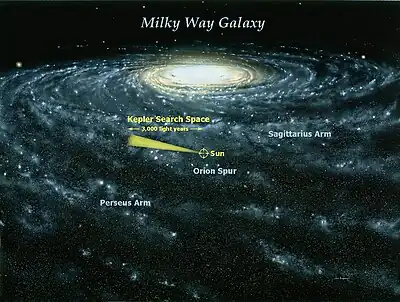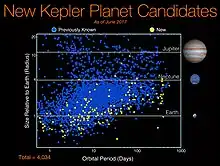KOI-7923.01
KOI-7923.01 est une possible exoplanète gravitant dans la zone habitable de l'étoile KIC 9084569 située dans la constellation du Cygne. Elle a été découverte en 2017 dans les données Kepler produites pendant la période d'observations 2009-2013[5],[6].

Champ de recherche de Kepler

Nouvelles planètes candidates de Kepler
KOI-7923.01, si son existence est confirmée, aurait une orbite de 395 jours, un rayon équivalent à 97 % de celui de la Terre, et une température de surface à peu près similaire aux régions polaires de cette dernière[7],[8].
En 2017, KOI-7923.01 est considérée comme une planète potentiellement colonisable[9].
Notes et références
- (en) Cet article est partiellement ou en totalité issu de l’article de Wikipédia en anglais intitulé « KOI-7923.01 » (voir la liste des auteurs).
- NASA Exoplanet Archive, (site web), consulté le
- SIMBAD Astronomical Database, (catalogue)
- (en) Susan E. Thompson, Jeffrey L Coughlin, Kelsey Hoffman, Fergal Mullally, Jessie L Christiansen, Christopher J Burke, Steve Bryson, Natalie Batalha, Michael R Haas, Joseph Catanzarite, Jason F. Rowe, Geert Barentsen, Douglas A. Caldwell, Bruce D Clarke, Jon M Jenkins, Jie Li, David W. Latham, Jack J. Lissauer, Savita Mathur, Robert L Morris, Shawn E Seader, Jeffrey C Smith, Todd C Klaus, Joseph D Twicken, Jeffrey E Van Cleve, Bill Wohler, Rachel Akeson, David R. Ciardi, William D Cochran, Christopher E Henze, Steve B Howell, Daniel Huber, Andrej Prša, Solange V Ramírez, Timothy D Morton, Thomas Barclay, Jennifer R Campbell, William J. Chaplin, David Charbonneau, Jørgen Christensen-Dalsgaard, Jessie L Dotson, Laurance Doyle, Edward W Dunham, Andrea K Dupree, Eric B. Ford, John C Geary, Forrest R Girouard, Howard Isaacson, Hans Kjeldsen, Elisa V Quintana, Darin Ragozzine, Avi Shporer, Victor Silva Aguirre, Jason H Steffen, Martin Still, Peter Tenenbaum, William F Welsh, Angie Wolfgang, Khadeejah A Zamudio, David G Koch, William J Borucki et William J. Borucki, « Planetary Candidates Observed by Kepler. VIII. A Fully Automated Catalog with Measured Completeness and Reliability Based on Data Release 25 », The Astrophysical Journal Supplement series, AAS, vol. 235, no 2, , p. 38 (ISSN 0067-0049 et 1538-4365, PMID 32908325, PMCID 7477822, DOI 10.3847/1538-4365/AAB4F9, arXiv 1710.06758)
- Data Processing and Analysis Consortium, Agence spatiale européenne, Gaia Data Release 2, (catalogue d'étoiles),
- NASA finds 20 habitable worlds 'hiding in plain sight' New Zealand herald 1 Nov, 2017.
- Xavier Demeersman, « 20 exoplanètes potentiellement habitables découvertes », Futura-Sciences, (lire en ligne, consulté le )
- Twenty Habitable Worlds Hiding In Plain Sight Spotted By , NDTV 1 November 2017.
- (en) Susan E Thompson, Jeffrey L Coughlin, Kelsey Hoffman, Fergal Mullally, Jessie L Christiansen et al., « Planetary Candidates Observed by Kepler. VIII. A Fully Automated Catalog With Measured Completeness and Reliability Based on Data Release 25 », . Kepler catalogue entry
- W. Harry Fortuna, « NASA has found another 20 promising planets for humans to colonize », sur Quartz (média), (consulté le )
Lien externe
- (en) 2MASS J19204798+4525121 -- Star sur la base de données Simbad du Centre de données astronomiques de Strasbourg.
- Portail de l’astronomie
Cet article est issu de Wikipedia. Le texte est sous licence Creative Commons – Attribution – Partage à l’identique. Des conditions supplémentaires peuvent s’appliquer aux fichiers multimédias.